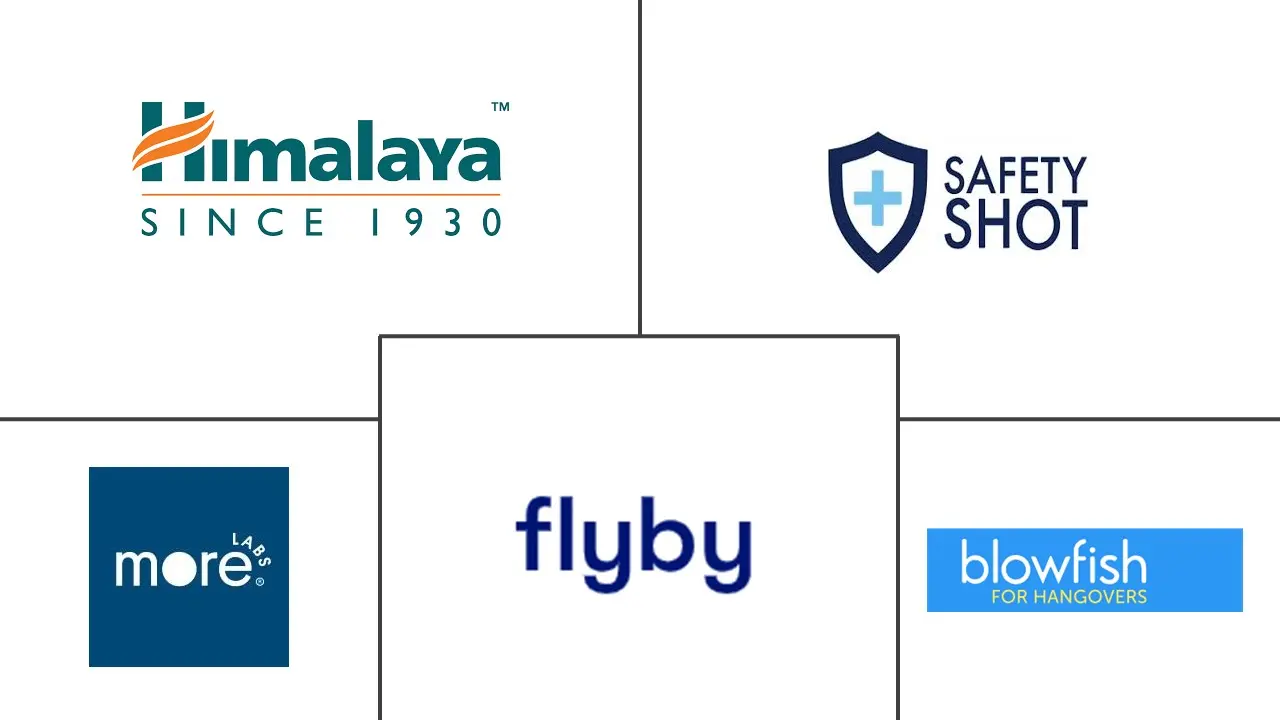Hangover Rehydration Supplements Market Size and Share
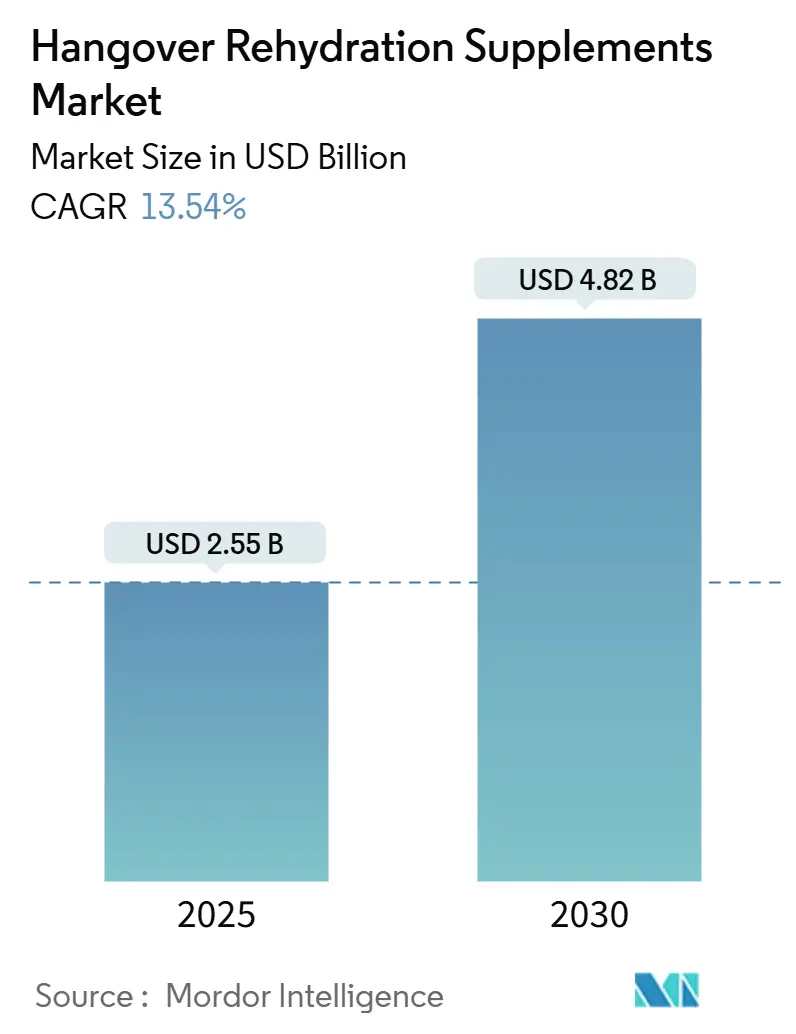
Hangover Rehydration Supplements Market Analysis by Mordor Intelligence
The hangover rehydration supplements market is valued at USD 2.55 billion in 2025 and is projected to reach USD 4.82 billion by 2030, advancing at a 13.54% CAGR. Rising wellness consciousness among consumers in their 20s and 30s, along with continued alcohol-related dehydration, sustains robust demand. Regulatory scrutiny in 2024 pushed brands toward science-backed formulations instead of dampening category enthusiasm[1]U.S. Food and Drug Administration, “Warning Letters and Regulatory Updates on Hangover Products,” fda.gov. Fragmentation defines the competitive field because specialty start-ups and large nutraceutical firms innovate simultaneously. Convenience-oriented ready-to-drink (RTD) shots, probiotic ingredients that target acetaldehyde, and expanding e-commerce penetration remain the strongest growth catalysts.
Key Report Takeaways
- By formulation, powders and effervescent sachets led with 35.67% of the hangover rehydration supplements market share in 2024, whereas RTD shots are forecast to grow at 15.45% CAGR to 2030.
- By functionality timing, post-drink recovery accounted for a 25.43% share of the hangover rehydration supplements market size in 2024, while in-drink maintenance products are advancing at 14.98% CAGR through 2030.
- By ingredient type, vitamin and mineral blends captured 30.65% revenue share in 2024; probiotic and enzyme-enhanced formulas are projected to expand at 14.67% CAGR to 2030.
- By distribution channel, pharmacies held 20.54% of the hangover rehydration supplements market size in 2024 as e-commerce platforms post 16.54% CAGR through 2030.
- By consumer group, millennials held 40.32% of the hangover rehydration supplements market size in 2024 as Gen Z post 15.89% CAGR through 2030.
- By geography, North America commanded 38.65% of the hangover rehydration supplements market share in 2024; Asia-Pacific registers the fastest 14.56% CAGR through 2030.
Global Hangover Rehydration Supplements Market Trends and Insights
Driver Impact Analysis
| Driver | % Impact on CAGR Forecast | Geographic Relevance | Impact Timeline |
|---|---|---|---|
| Increasing Global Alcohol Consumption Levels | +2.8% | North America & Europe | Medium term (2–4 years) |
| Rising Consumer Preference For Preventive Health Supplements | +3.2% | North America & APAC urban centers | Long term (≥ 4 years) |
| Expansion Of E-Commerce Distribution For Nutraceuticals | +2.1% | Global | Short term (≤ 2 years) |
| Growing Millennial And Gen Z Wellness Consciousness | +2.9% | Urban markets worldwide | Long term (≥ 4 years) |
| Corporate Workplace Wellness Programs Covering Hangover Recovery | +1.6% | Global corporate hubs | Medium term (2–4 years) |
| Emergence Of Functional Ingredients With Clinically Proven Hangover Efficacy | +2.4% | Global | Long term (≥ 4 years) |
| Source: Mordor Intelligence | |||
Increasing Global Alcohol Consumption Levels
Binge drinking among young adults holds steady despite moderation narratives, creating recurring need for hangover solutions. University‐led research on dihydromyricetin shows that new products target liver protection as well as symptom relief. Such evidence turns occasional users into routine buyers, because supplements are now viewed as proactive wellness tools. Academic studies also link frequent hangover-remedy usage with alcohol use disorder symptoms, which paradoxically enlarges the addressable pool of users.
Rising Consumer Preference for Preventive Health Supplements
Controlled trials by Morning Recovery reported 80% symptom reduction when the supplement is taken before drinking. Probiotic offerings such as Myrkl, priced at USD 25–35 per dose, can eliminate up to 70% of alcohol within 60 minutes. Employers now include these products in corporate wellness programs, which validates preventive usage while increasing unit throughput for vendors.
Expansion of E-Commerce Distribution for Nutraceuticals
Over-the-counter (OTC) products worth more than USD 40 billion migrate online at an annual 3.5% growth rate. Hangover brands that launch on Amazon regularly sell out within days, showcased by Safety Shot’s 2024 debut. Digital storefronts also educate buyers on enzyme science, strengthening trust and enabling subscription revenue streams.
Growing Millennial and Gen Z Wellness Consciousness
Gen Z integrates supplements into social drinking as routine self-care. The Los Angeles Times highlights how younger consumers eagerly test probiotic solutions despite expert caution. Millennials, holding 40.32% of the consumer base, pay premiums for clinically backed products, which encourages ongoing R&D investments among suppliers.
Restraints Impact Analysis
| Restraints Impact Analysis | (~) % Impact on CAGR Forecast | Geographic Relevance | Impact Timeline |
|---|---|---|---|
| Regulatory Uncertainty Regarding Hangover Claims | −1.8% | North America & Europe | Medium term (2–4 years) |
| Presence Of Counterfeit And Unverified Products Online | −1.5% | Global, higher in emerging markets | Short term (≤ 2 years) |
| Shift Towards Low Or No-Alcohol Beverages | −1.2% | North America, Europe, emerging APAC | Long term (≥ 4 years) |
| Social Stigma Around Reliance On Hangover Remedies | −1.0% | Global, conservative markets | Short term (≤ 2 years) |
| Source: Mordor Intelligence | |||
Regulatory Uncertainty Regarding Hangover Claims
The FDA issued warning letters to 7 brands in 2024, forcing shifts from cure claims to structure-function statements. Legal and scientific compliance raises entry barriers for small operators but provides competitive differentiation for firms that complete rigorous clinical trials. The National Advertising Division’s acceptance of qualified claims shows that approval remains possible with strong data[2]NutraIngredients-Asia, “Dongsung Bio Pharm Secures Funding,” nutraingredients-asia.com.
Shift Toward Low or No-Alcohol Beverages
Moderation trends limit occasions for severe hangovers. Yet binge episodes persist, and some beverage producers now integrate turmeric or similar extracts directly into alcoholic drinks to retain consumers. As a result, demand for standalone supplements falls modestly instead of collapsing outright.
Segment Analysis
By Formulation: RTD Innovation Challenges Powder Dominance
Powders and effervescent sachets accounted for 35.67% of the hangover rehydration supplements market share in 2024. RTD shots, though smaller in base, are expanding at a 15.45% CAGR because on-the-go users prefer single-serve convenience. The hangover rehydration supplements market size for RTD products is therefore predicted to widen sharply between 2025 and 2030. Demand for tablets and capsules remains steady among traditional supplement buyers, while gummies and oral strips appeal to younger customers seeking novel delivery methods.
RTD innovation faces regulatory complexity. The FDA continues to refine guidance that differentiates liquid supplements from beverages, which can slow product approvals. C.L.Pharm’s orally dissolving films deliver faster absorption and command premium shelf prices. Asian consumer acceptance of these formats supports international rollouts that challenge established powder dominance.
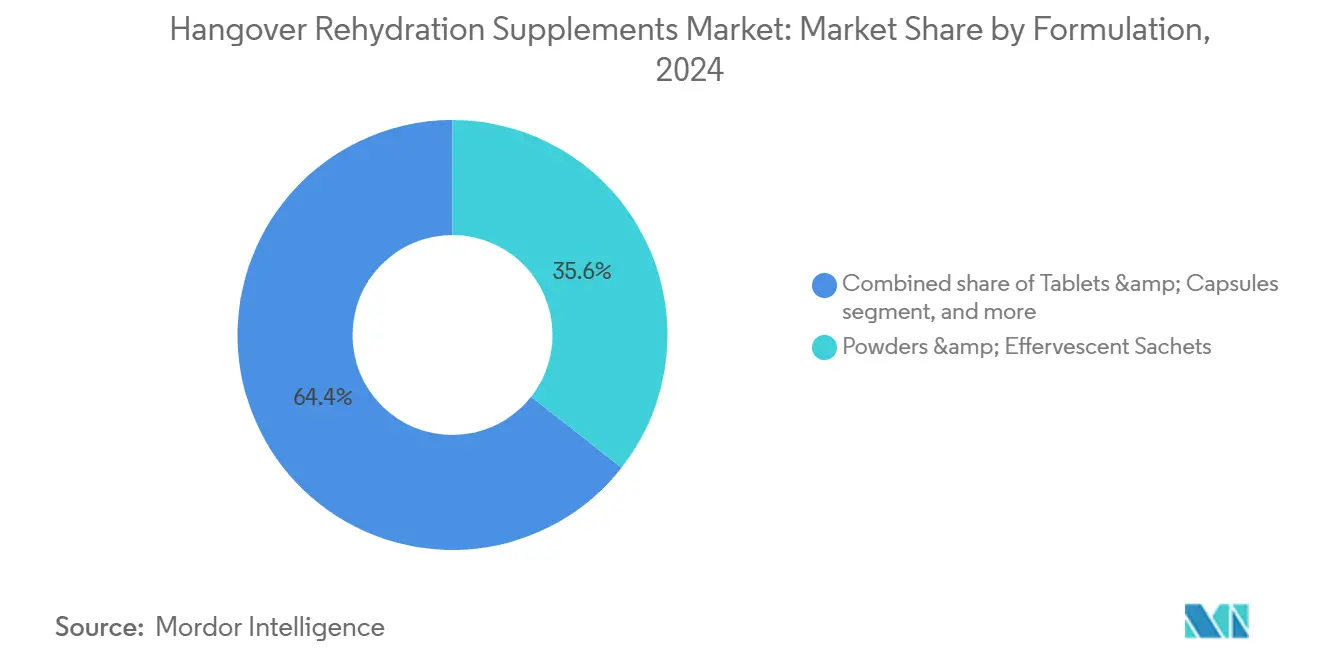
Note: Segment shares of all individual segments available upon report purchase
By Functionality Timing: Prevention Gains Momentum Over Recovery
Post-drink recovery products led 2024 revenue with 25.43% of the hangover rehydration supplements market size, but in-drink maintenance items are pacing 14.98% CAGR. This reflects a shift toward proactive wellness where users consume supplements during or before drinking. Clinical data from ZBiotics indicate real-time enzymatic breakdown of acetaldehyde. Morning Recovery has also shown efficacy for pre-drinking regimes, elevating demand for early-timing solutions.
Preventive tools benefit from subscription sales and corporate wellness adoption. Even so, many consumers still rely on familiar next-morning recovery sachets for immediate symptom relief. Dual-use portfolios, offering both pre- and post-drink products, give brands resilience against shifting consumption habits.
By Ingredient Type: Probiotics Challenge Vitamin Dominance
Vitamin and mineral blends held 30.65% market share in 2024, yet probiotic and enzyme formulations are advancing at 14.67% CAGR. The hangover rehydration supplements market largely credits ZBiotics’ engineered Bacillus subtilis strain for this pivot toward microbiome solutions. Botanical extracts such as Hovenia dulcis and Korean pear juice also gain ground after peer-reviewed trials confirm alcohol metabolism benefits.
Ingredient diversification draws pharmaceutical-style R&D budgets. Dongsung Bio Pharm invested KRW 570 million to explore endemic botanicals, reflecting regional innovation cycles. As clinical evidence grows, consumers trade up from basic B-vitamin blends to mechanistic probiotics, expanding average selling prices.
By Distribution Channel: E-Commerce Disrupts Traditional Retail
Pharmacies kept 20.54% of 2024 revenue, but e-commerce posts the strongest 16.54% CAGR. The hangover rehydration supplements market size generated online is on track to double by 2030 as direct-to-consumer (DTC) models overcome geographic retail gaps. Amazon sell-outs prove online demand velocity, while brand websites capture subscription buyers.
Brick-and-mortar remains relevant. Cheers Health extended to 3,000 convenience outlets with Lil’ Drug Store Products. Grocery chains add mainstream visibility, and specialty stores offer expert guidance on complex formulas. This multichannel mix cushions suppliers against platform risk.
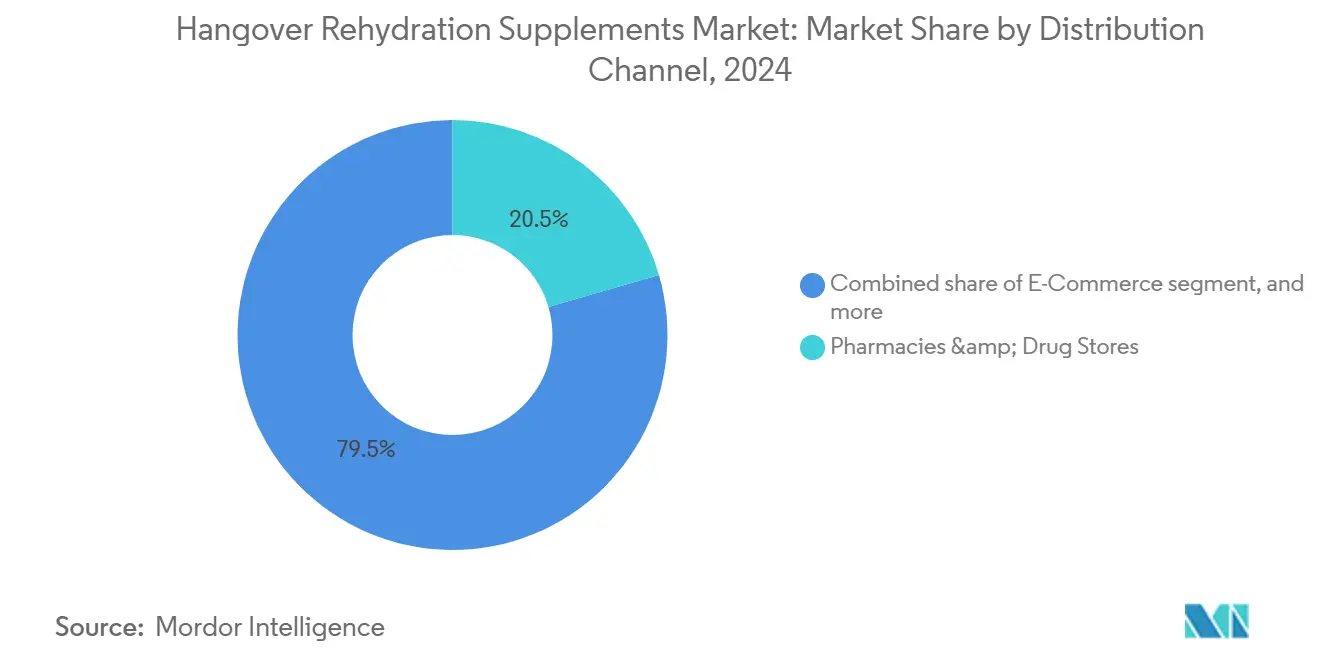
Note: Segment shares of all individual segments available upon report purchase
By Consumer Group: Gen Z Acceleration Challenges Millennial Leadership
Millennials commanded 40.32% revenue in 2024. Gen Z, however, increases spending at a 15.89% CAGR, narrowing the gap rapidly. The hangover rehydration supplements market finds Gen Z willing to adopt novel probiotics despite limited longitudinal data[3]Los Angeles Times, “Probiotic Hangover Pills Raise Questions,” latimes.com. Gen X and Boomers account for smaller yet higher ticket purchases because they favor premium science-backed options.
Digital nativity shapes buying journeys. Gen Z uses social media to discover brands, favoring transparent efficacy claims. Millennials, by contrast, respond to workplace wellness incentives and family-sized multipacks. Targeted messaging therefore differs across cohorts, requiring agile marketing.
Geography Analysis
North America led with 38.65% market share in 2024 and is expected to retain influence through 2030. FDA oversight creates both hurdles and strategic advantages for compliant firms. Brands such as Safety Shot secure patents and leverage strong retail infrastructure to sustain premium price points. Corporate wellness integration further entrenches category demand.
Asia-Pacific is the fastest grower at 14.56% CAGR. Rising disposable income and evolving social drinking norms accelerate category uptake in South Korea and Japan. Government-supported research into native botanicals, like Dongsung Bio Pharm’s project, modernizes traditional remedies with clinical evidence. Delivery innovations—including orally dissolving films—match the region’s appetite for convenient functional products.
Europe offers sizable but complex potential because regulations vary widely. Consumers embrace functional foods, and cross-border ingredient flows bring Korean pear juice and Hovenia dulcis products into EU channels. Companies that localize labeling and comply with varied health-claim standards can capture share. Regional moderation trends temper growth, yet premium preventive supplements offset lower volume with higher unit value.
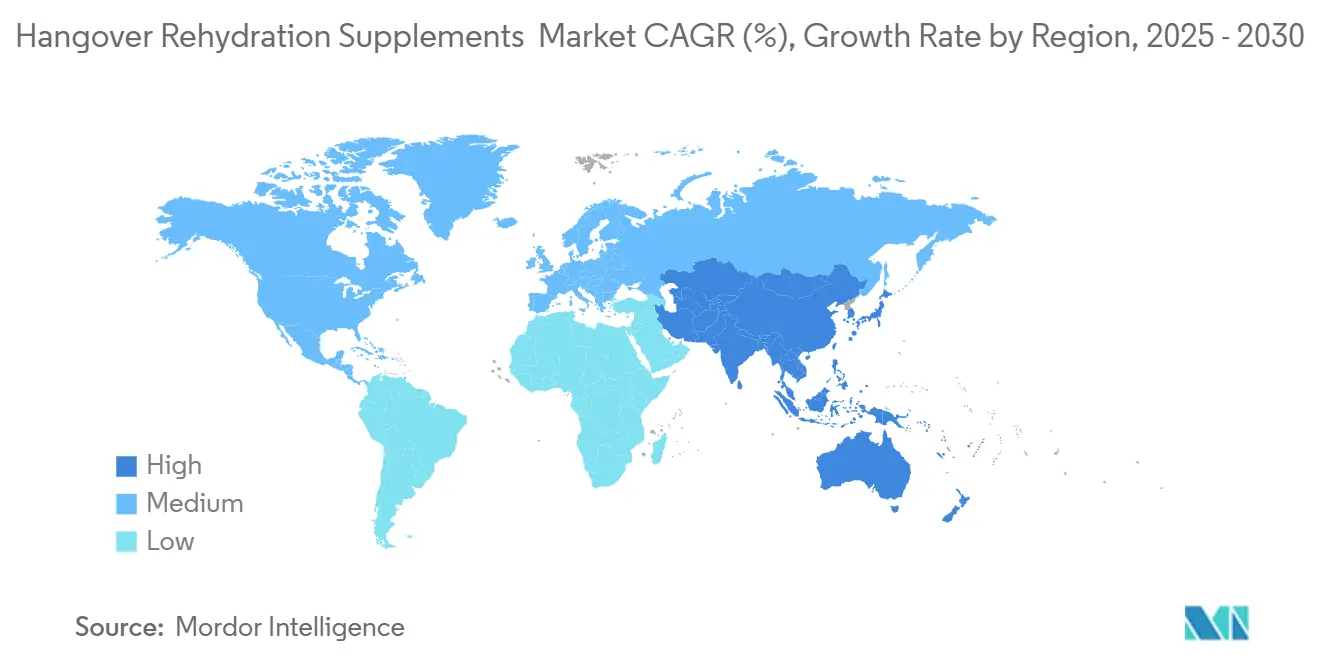
Competitive Landscape
The hangover rehydration supplements market remains moderately fragmented. Top players hold limited combined share because ingredient knowledge and contract manufacturing lower entry barriers. Yet regulatory compliance costs and the need for published clinical data drive gradual consolidation. Biotech entities such as ZBiotics build defensible positions through patents and peer-reviewed evidence.
Strategic moves vary. Multinationals like Unilever entered the space by investing in Create Wellness in 2024, signaling broader consumer-goods interest. Digital-native brands pursue DTC subscription models, while pharmacy-oriented players cultivate healthcare professional endorsements. Intellectual-property portfolios around delivery formats and enzymes increasingly differentiate winners from commodity suppliers.
Technology adoption centers on improved bioavailability and real-time digital education. Firms invest in enzyme encapsulation, orally dissolving films, and AI-driven content to explain science in plain language. As clinical transparency grows, consumer skepticism declines, lifting category credibility.
Hangover Rehydration Supplements Industry Leaders
-
More Labs
-
Rally Labs LLC
-
Flyby
-
Himalaya Global Holdings Ltd
-
Safety Shot Inc.
- *Disclaimer: Major Players sorted in no particular order
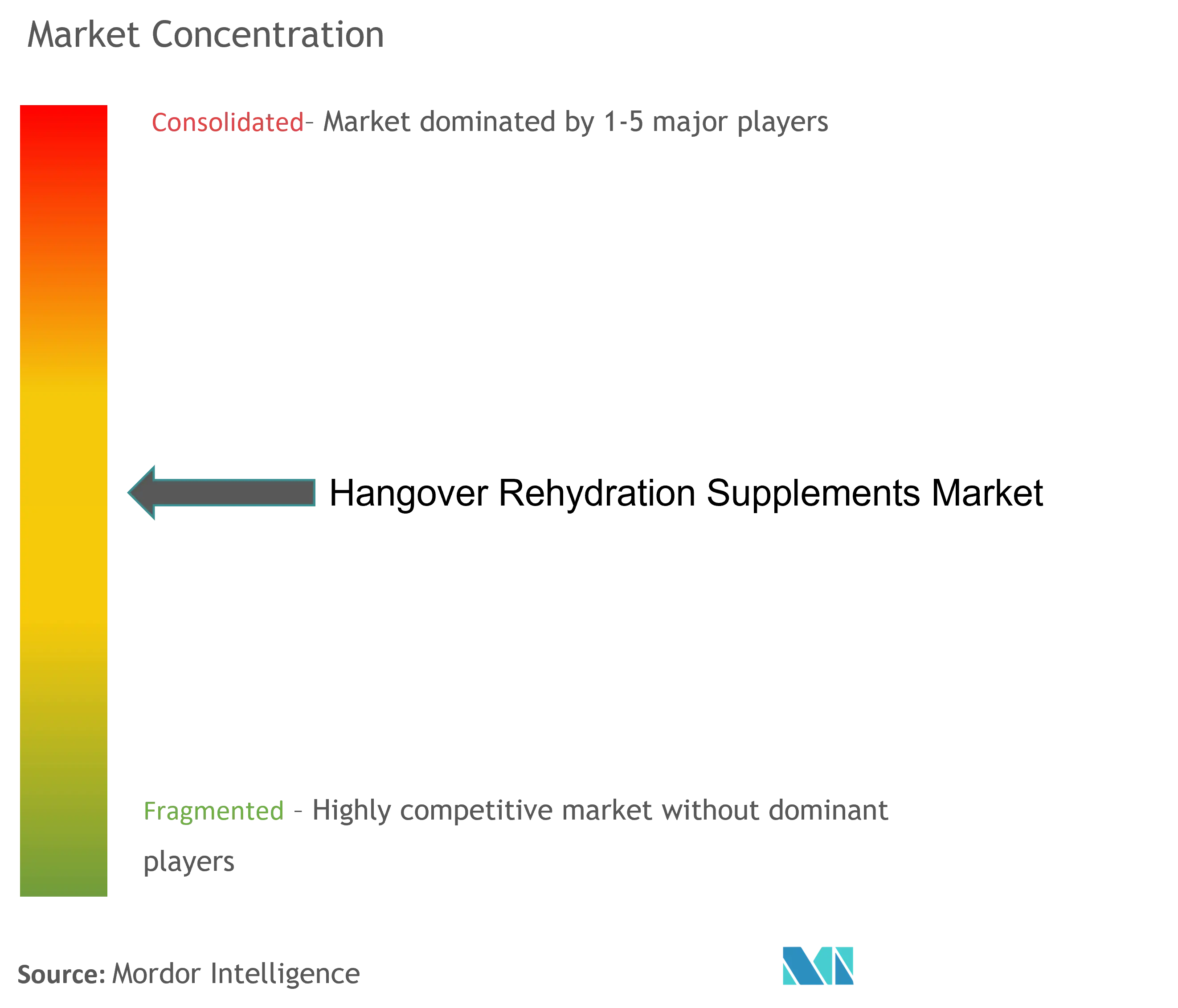
Recent Industry Developments
- May 2025: C.L.Pharm announced expansion of orally dissolving film hangover remedies into Singapore and Malaysia, using Dr.FiLL Bio SorbFilm technology for faster absorption.
- April 2025: Dongsung Bio Pharm secured KRW 570 million in government funding to develop products featuring Hwangchil and Dangyuja, with human trials scheduled.
- January 2025: Peer-reviewed journals published new studies on Hovenia dulcis extract combinations and glutathione, strengthening scientific support for hangover supplements.
- December 2024: Los Angeles Times investigation detailed consumer interest in probiotic hangover products like ZBiotics and Myrkl while noting expert skepticism.
- September 2024: Unilever invested in Create Wellness, spotlighting mainstream consumer-goods interest in the category.
Research Methodology Framework and Report Scope
Market Definitions and Key Coverage
Our study defines the hangover rehydration supplements market as ingestible products, tablets, powders, effervescent sachets, ready-to-drink shots, and oral strips, formulated to accelerate alcohol metabolism, replace lost electrolytes, and ease post-intoxication fatigue. These items contain B-vitamins, amino acids, botanical extracts, and mineral blends that target acetaldehyde breakdown while restoring fluid balance.
Scope Exclusion: Single-serve sports electrolyte beverages and intravenous recovery services are outside the study.
Segmentation Overview
- By Formulation
- Tablets & Capsules
- Powders & Effervescent Sachets
- Ready-to-Drink (RTD) Shots
- Oral Strips & Gummies
- By Functionality Timing
- Pre-Drink Prevention
- In-Drink Maintenance
- Post-Drink Recovery
- By Ingredient Type
- Botanical Extract Based
- Vitamin & Mineral Blends
- Amino-Acid / NADH Focused
- Probiotic / Enzyme-Enhanced
- By Distribution Channel
- Pharmacies & Drug Stores
- E-Commerce
- Convenience & Gas Station Retail
- Grocery & Mass Retail
- Specialty Supplement Stores
- By Consumer Group
- Gen Z
- Millennials
- Gen X
- Baby Boomers
- Geography
- North America
- United States
- Canada
- Mexico
- Europe
- Germany
- United Kingdom
- France
- Italy
- Spain
- Rest of Europe
- Asia-Pacific
- China
- Japan
- India
- Australia
- South Korea
- Rest of Asia-Pacific
- Middle East & Africa
- GCC
- South Africa
- Rest of Middle East & Africa
- South America
- Brazil
- Argentina
- Rest of South America
- North America
Detailed Research Methodology and Data Validation
Primary Research
Mordor analysts interviewed product formulators, contract manufacturers, pharmacy buyers, and leading e-commerce category managers across North America, Europe, and Asia-Pacific. These discussions clarified dosage norms, average selling prices, consumer repeat rates, and regulatory friction points, allowing us to firm up desk-research assumptions.
Desk Research
We opened our work with structured desk research, drawing on tier-1 public datasets such as the WHO Global Status Report on Alcohol and Health, CDC Behavioral Risk Factor Surveillance System, UN COMTRADE shipment codes for taurine and electrolytes, the USDA Dietary Supplement Label Database, and regulatory notices from the US FDA and EFSA. Financial filings, retailer sell-through disclosures, and peer-reviewed journals in Nutrients and the Journal of Food Science further grounded inputs. Select paid repositories, D&B Hoovers for manufacturer revenue splits and Dow Jones Factiva for deal flow, helped triangulate private-company footprints. The sources cited here are illustrative; many additional references supported validation.
Market-Sizing & Forecasting
We constructed a top-down model beginning with per-capita alcohol consumption, heavy-drinking prevalence, and average incidence of hangover-related supplement use. These volumes were multiplied by country-level median ASPs and then cross-checked through selective bottom-up roll-ups of major brand shipments and channel receipts. Variables such as social-media search interest for 'hangover cure,' discretionary income growth, regulatory warning events, and e-commerce share were stress-tested. Forecasts to 2030 deploy multivariate regression blended with scenario analysis to capture shifts in drinking culture and wellness adoption. Data gaps, particularly in emerging markets, were bridged with regional analogs and validated by expert calls before final calibration.
Data Validation & Update Cycle
Outputs pass a two-tier analyst review where variance against external benchmarks triggers deeper dives. Anomalies are flagged, reconciled, and then signed off by a senior reviewer. Our models refresh annually, and we issue interim updates whenever material events, such as ingredient bans or tax shifts, alter demand patterns. A brief reconfirmation is performed before each client delivery.
Why Mordor's Hangover Rehydration Supplements Baseline Commands Credibility
Published estimates often diverge because firms apply different product scopes, base years, and refresh cadences, leading to numbers that can confuse decision-makers.
Key gap drivers include whether prevention-only patches are counted, if sports electrolyte drinks are folded into totals, the depth of primary validation, and currency-conversion timing. Our disciplined scope selection, annual refresh, and mixed-method modeling minimize these distortions and give users a consistent, reproducible baseline.
Benchmark comparison
| Market Size | Anonymized source | Primary gap driver |
|---|---|---|
| USD 2.55 B (2025) | Mordor Intelligence | - |
| USD 2.52 B (2024) | Regional Consultancy A | Excludes prevention formats, older base year, limited expert input |
| USD 6.89 B (2024) | Global Consultancy B | Bundles sports electrolyte drinks, relies mainly on retail scanner data |
| USD 2.05 B (2022) | Trade Journal C | Converts ingredient trade flows without consumer-level adjustment |
These comparisons show that Mordor Intelligence delivers a balanced, transparent figure tied to clear variables and repeatable steps, giving stakeholders a dependable launchpad for strategy.
Key Questions Answered in the Report
What is the current value of the hangover rehydration supplements market?
The hangover rehydration supplements market is valued at USD 2.55 billion in 2025.
How fast is the hangover rehydration supplements market expected to grow?
The market is projected to expand at a 13.54% CAGR, reaching USD 4.82 billion by 2030.
Which formulation type is growing the quickest?
Ready-to-drink shots post the highest 15.45% CAGR through 2030 thanks to on-the-go convenience.
Why is Asia-Pacific the fastest-growing region?
Rising disposable income, evolving social drinking habits, and modernization of traditional remedies push Asia-Pacific growth at 14.56% CAGR.
How are regulations affecting new product launches?
FDA and EU authorities now require substantiated structure-function claims, which raises development costs but favors firms with clinical data.
Which ingredients are gaining popularity beyond vitamins?
Probiotic strains that break down acetaldehyde and botanical extracts like Hovenia dulcis are advancing quickly due to stronger scientific validation. . . . . . . . New Research
Page last updated on:
